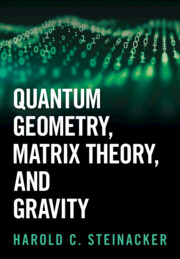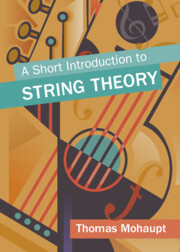Refine search
Actions for selected content:
33 results
1 - Introduction
-
- Book:
- Modular Forms and String Theory
- Published online:
- 28 November 2024
- Print publication:
- 12 December 2024, pp 1-6
-
- Chapter
- Export citation
13 - Gone to Texas
-
- Book:
- Steven Weinberg: A Life in Physics
- Published online:
- 22 November 2024
- Print publication:
- 12 December 2024, pp 173-209
-
- Chapter
- Export citation

Modular Forms and String Theory
-
- Published online:
- 28 November 2024
- Print publication:
- 12 December 2024

Quantum Geometry, Matrix Theory, and Gravity
-
- Published online:
- 04 April 2024
- Print publication:
- 11 April 2024
Introduction
-
- Book:
- A Short Introduction to String Theory
- Published online:
- 31 March 2022
- Print publication:
- 07 April 2022, pp xvi-xviii
-
- Chapter
- Export citation

A Short Introduction to String Theory
-
- Published online:
- 31 March 2022
- Print publication:
- 07 April 2022
25 - Nathan Seiberg
-
- Book:
- Conversations on Quantum Gravity
- Published online:
- 05 August 2021
- Print publication:
- 26 August 2021, pp 481-492
-
- Chapter
- Export citation
21 - Joseph Polchinski
-
- Book:
- Conversations on Quantum Gravity
- Published online:
- 05 August 2021
- Print publication:
- 26 August 2021, pp 407-427
-
- Chapter
- Export citation
37 - Edward Witten
-
- Book:
- Conversations on Quantum Gravity
- Published online:
- 05 August 2021
- Print publication:
- 26 August 2021, pp 698-698
-
- Chapter
- Export citation
34 - Erik Verlinde
-
- Book:
- Conversations on Quantum Gravity
- Published online:
- 05 August 2021
- Print publication:
- 26 August 2021, pp 651-670
-
- Chapter
- Export citation
26 - Ashoke Sen
-
- Book:
- Conversations on Quantum Gravity
- Published online:
- 05 August 2021
- Print publication:
- 26 August 2021, pp 493-512
-
- Chapter
- Export citation
2 - Nima Arkani-Hamed
-
- Book:
- Conversations on Quantum Gravity
- Published online:
- 05 August 2021
- Print publication:
- 26 August 2021, pp 33-61
-
- Chapter
- Export citation
31 - Leonard Susskind
-
- Book:
- Conversations on Quantum Gravity
- Published online:
- 05 August 2021
- Print publication:
- 26 August 2021, pp 599-613
-
- Chapter
- Export citation
22 - Alexander Polyakov
-
- Book:
- Conversations on Quantum Gravity
- Published online:
- 05 August 2021
- Print publication:
- 26 August 2021, pp 428-439
-
- Chapter
- Export citation
27 - Eva Silverstein
-
- Book:
- Conversations on Quantum Gravity
- Published online:
- 05 August 2021
- Print publication:
- 26 August 2021, pp 513-530
-
- Chapter
- Export citation
12 - Rajesh Gopakumar
-
- Book:
- Conversations on Quantum Gravity
- Published online:
- 05 August 2021
- Print publication:
- 26 August 2021, pp 240-254
-
- Chapter
- Export citation
33 - Cumrun Vafa
-
- Book:
- Conversations on Quantum Gravity
- Published online:
- 05 August 2021
- Print publication:
- 26 August 2021, pp 636-650
-
- Chapter
- Export citation
15 - Petr Hořava
-
- Book:
- Conversations on Quantum Gravity
- Published online:
- 05 August 2021
- Print publication:
- 26 August 2021, pp 297-319
-
- Chapter
- Export citation
19 - Hermann Nicolai
-
- Book:
- Conversations on Quantum Gravity
- Published online:
- 05 August 2021
- Print publication:
- 26 August 2021, pp 373-390
-
- Chapter
- Export citation
4 - Jan de Boer
-
- Book:
- Conversations on Quantum Gravity
- Published online:
- 05 August 2021
- Print publication:
- 26 August 2021, pp 101-121
-
- Chapter
- Export citation
